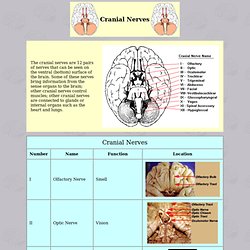

Www.topsite.com/goto/sharpbrains.com. Brain Explorer. The brain&s silent majority - 2009 FALL. When you have no clue, call it glue.

“Glia,” the Greek word for glue, was the name the pathologist Rudolph Virchow gave, back in 1856, to the gelatinous substance that forms the bulk of the brain. And it stuck. These days, scientists use it to denote the matter that accounts for 90 percent of the brain’s cells and more than half its volume — but, like the late comic Rodney Dangerfield, “can’t get no respect.” Neurons, the “talented tenth” of the human brain that hog the lion’s share of brain scientists’ attention, are indeed a work of evolutionary art. They’ve got a knack that glia lack: Their aptitude for high-speed, long-distance communication makes them the nervous system’s premier information processors.
Blog & The Crazy World of Visual Hallucinations. Cranial Nerves. Can't remember the names of the cranial nerves?

Here is a handy-dandy mnemonic for you: On Old Olympus Towering Top AFamous Vocal German Viewed Some Hops. The bold letters stand for: Home page - StumbleUpon. Neuroscience News - Neuroscience Research Neuroscience Labs Neuroscience Jobs Neuroscience Books Reviews Neuroscience Forums Social Network. Etymology of Neuroscience Terms - StumbleUpon. History of Neuroscience. Neurological Control - Neurotransmitters - StumbleUpon. Neurotransmitter Molecules Neurotransmitters can be broadly split into two groups – the ‘classical’, small molecule neurotransmitters and the relatively larger neuropeptide neurotransmitters.

Within the category of small molecule neurotransmitters, the biogenic amines (dopamine, noradrenaline, serotonin and histamine) are often referred to as a discrete group because of their similarity in terms of their chemical properties. Brain Fitness And Memory Programs, Brain Training - CogniFit - StumbleUpon.